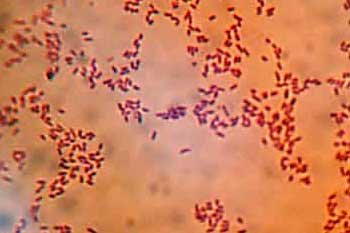Breakthrough in the mystery of Asian shrimp farm deaths

Researchers at the University of Arizona have identified the causative agent behind a mysterious disease that has been decimating shrimp farms in Asia.
The disease, known as Shrimp Early Mortality Syndrome (EMS) or Acute Hepatopancreatic Necrosis Syndrome (AHPNS), has for the past two years caused large-scale die-offs of cultivated shrimp in several countries in Asia, where 1 million people depend on shrimp aquaculture for their livelihoods.
In 2011, the Asian region produced 3 million tonnes of shrimp, with a production value of $13.3 billion.
Infected shrimp ponds experience extremely high levels of mortality early in their growing cycle — as high as 100% death rates in some cases.
So far, the cause of the illness has baffled scientists, animal health authorities and farmers, making prevention and treatment difficult. But now culprit has been identified – a strain of a bacterium commonly found in brackish coastal waters around the globe, Vibrio parahaemolyticus. This was a crucial first step in finding effective ways to combat EMS
EMS/AHPNS initially surfaced in 2009. By 2010 outbreaks had become serious. In China in 2011, farms in Hainan, Guangdong, Fujian and Guangxi suffered almost 80% losses. In Thailand, shrimp production for 2013 is predicted to be down 30% from last year due to EMS. Production on some farms in eastern parts of the country has been cut by 60%.
No risk to human health
Some rare strains of V. parahaemolyticus do cause gastrointestinal sickness in humans — through the consumption of raw or undercooked shrimp and oysters — but only strains carrying two specific genes cause human disease.
Just 1-2% of wild V. parahaemolyticus strains worldwide contain these two genes — and the strain identified by research team as responsible for EMS is not among them.
“There have been no reports of human illness being associated with EMS, and these new findings would tend to confirm that EMS-infected shrimp do not pose a health risk to people,” said Iddya Karunasagar, a seafood safety expert at FAO.
Only shrimp vulnerable
EMS affects two species of shrimp commonly raised around the world, the Giant Tiger Prawn and Whiteleg Shrimp.
Clinical signs of the disease include lethargy, slow growth, an empty stomach and midgut and a pale and atrophied hepatopancreas (an internal digestive organ that serves the function of a liver), often with black streaks. Within 30 days of a pond being stocked large-scale die-offs begin.
So far countries officially reporting EMS include China, Malaysia, Thailand and Vietnam.
But anyplace where P. monodon and P. vannamei are cultivated is potentially at risk. This includes most of Asia and much of Latin America, where shrimp farming is also important, as well African countries where shrimp are cultivated (Madagascar, Egypt, Mozambique and Tanzania).
Disease spread would appear to be linked to proximity to already-infected farms or the movement of infected live shrimp, usually juveniles used to stock ponds.
The team were unable to reproduce EMS using frozen and thawed shrimp samples, suggesting freezing kills the responsible bacterium. Since international shrimp trade is mostly in frozen form, there is apparently no or very low risk of disease transmission from these products.
Dealing with EMS
Now that EMS’s causative agent is known more research is urgently needed to have a better understanding of how the disease spreads from farm to farm and implement appropriate countermeasures.
At the same time, FAO is engaging with partners to organize a concerted, inter-regional effort to address the disease.
For shrimp farmers, reliance on already-established aquaculture and biosecurity best practices will help prevent EMS-related problems. These include:
- Post-larvae shrimp used for stocking should be purchased from reputable sellers, be accompanied by animal health certificates prior to being introduced on-farm, and subjected to a temporary quarantine prior to stocking.
- High quality feed should be used, and environmental stresses avoided, to keep shrimp healthy.
- The health of pond environments should be carefully maintained and young shrimp should be closely monitored. Any illness should be immediately reported to the proper authorities.
- Regular fallowing of aquaculture ponds should be considered as part of a routine on-farm program of aquatic animal health, as this practice has been shown to break pathogen life cycles.
Off farm, any movement of live or unfrozen shrimp products should also comply with established best practices.
The effort to study EMS, identify its pathology and respond to EMS was supported by a coalition of partners including UA; FAO; the World Organisation for Animal Health (OIE); the World Bank; the Network of Aquaculture Centres in Asia-Pacific (NACA); the Global Aquaculture Alliance (GAA); the Ministry of Agriculture and Rural Development of Viet Nam; CP Foods; the Minh Phu Seafood Corporation; Grobest Inc. and the Uni-President Feed Company.











